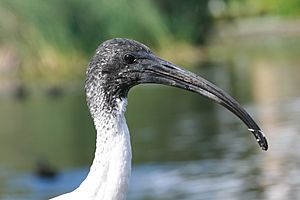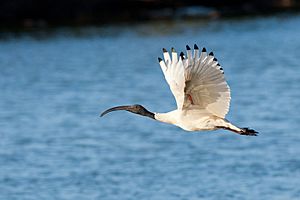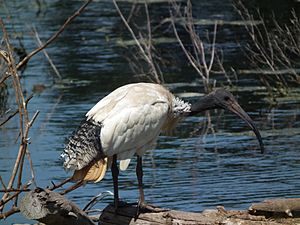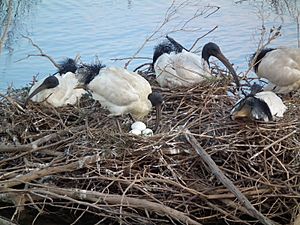Australian white ibis facts for kids
Quick facts for kids Australian white ibis |
|
|---|---|
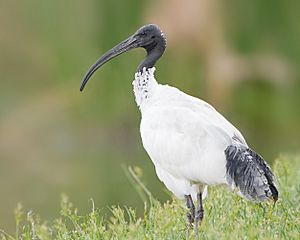 |
|
| Conservation status | |
| Scientific classification | |
| Genus: |
Threskiornis
|
| Species: |
molucca
|
| Subspecies | |
|
|
| Synonyms | |
|
Threskiornis moluccus |
|
The Australian white ibis (Threskiornis molucca) is a type of wading bird from the ibis family. You can find these birds all over Australia. They are easy to spot because they have mostly white feathers, a bare black head, a long curved black beak, and black legs. This bird is closely related to the sacred ibis.
Even though they used to be rare in cities, Australian white ibises have moved into urban areas on the east coast since the late 1970s. Now, you can often see them in cities like Wollongong, Sydney, Melbourne, the Gold Coast, Brisbane, and Townsville. Recently, they have also become common in Perth, Western Australia, and nearby towns. Sadly, their numbers have dropped in their natural breeding places, such as the Macquarie Marshes in New South Wales. Plans have been put in place to manage their growing numbers in cities like Sydney.
Because they are seen more often in cities and sometimes search for food in rubbish bins, people have given them funny nicknames like "tip turkey" and "bin chicken." These birds have become a popular part of Australian culture, and people often have strong feelings about them – both good and bad!
The Yindjibarndi people, who live in the central and western Pilbara region, call this bird mardungurra.
Contents
Meet the Australian White Ibis
The Australian white ibis is a fairly large bird. It usually measures about 65 to 75 centimeters (25 to 30 inches) long. It has a bald black head and neck, and a long black beak that curves downwards. The male's beak is usually longer than the female's.
Male ibises are a bit heavier than females. Males weigh between 1.7 and 2.5 kilograms (3.7 to 5.5 pounds), while females weigh 1.4 to 1.9 kilograms (3.1 to 4.2 pounds). For comparison, the American white ibis usually weighs about 1 kilogram (2.2 pounds).
The main body feathers are white, but they can sometimes look brownish. When the bird is breeding, its upper tail feathers turn yellow. The legs and feet are dark, and you can see red skin under their wings when they fly. Young ibises have shorter beaks, and their heads and necks are covered in feathers.
The call of the Australian white ibis is a long, croaking sound. These birds can live for a long time, sometimes up to 28 years. They are ready to have their own chicks when they are about three years old.
Where Do Ibises Live?
The Australian white ibis lives in eastern, northern, and south-western Australia. They like marshy wetlands, especially near open grassy areas. They have become very common in city parks and rubbish dumps along Australia's east coast. You can see them in cities like Wollongong, Sydney, Perth, the Gold Coast, Brisbane, and Townsville.
Historically, these birds were not often seen in cities. The first big group moved into urban areas after a drought in the late 1970s pushed them eastward. Their numbers in cities grew even more after another drought in 1998. One of the first large groups settled in the Sydney suburb of Bankstown. This group was thought to be the biggest outside of the Macquarie Marshes, which is their natural breeding wetland.
There has been some discussion about whether these birds are a problem or if they might be a species that needs protection. In tourist areas of Sydney, like Darling Harbour, the Royal Botanic Gardens, and Centennial Park, the ibises have caused issues because of their strong smell. To manage their numbers, some ibis populations in these areas have been controlled.
In Victoria, these birds are also sometimes seen as a problem. They search through rubbish bins and tips, scattering trash everywhere. They are even known to snatch sandwiches from people having picnics! Because of this behavior, and because they sometimes build nests in inconvenient places, some birds were moved from Healesville Sanctuary to Sale. However, the birds often returned within a few days.
The Macquarie Marshes in north-western New South Wales used to be a major breeding area for these birds. However, no ibises have been reported breeding there since 2000. Before that, in 1998, there were 11,000 pairs breeding there. You won't find this species in Tasmania.
Ibis Habits and Life
What Do Ibises Eat?
The Australian white ibis eats many different things. Their diet includes insects and other small creatures found on land and in water. They also enjoy human food scraps, especially in cities. Their favorite foods are crayfish and mussels, which they find by digging with their long beaks.
How Do Ibises Raise Their Young?
The breeding season for Australian white ibises changes depending on where they live in Australia. In the south, they usually breed from August to November. In the north, they breed from February to May, after the wet season.
Their nest is a shallow, dish-shaped platform made of sticks, grasses, or reeds. They usually build their nests in trees, close to water sources like rivers, swamps, or lakes. Ibises often nest near other waterbirds, such as egrets, herons, spoonbills, or cormorants.
A female ibis usually lays two to three dull white eggs. Each egg is about 65 millimeters (2.5 inches) long and 44 millimeters (1.7 inches) wide. The parents then sit on the eggs for 21 to 23 days until they hatch. When the chicks hatch, they are born naked and helpless. It takes about 48 days for the young birds to grow enough feathers to fly.
Images for kids
See also
 In Spanish: Ibis blanco australiano para niños
In Spanish: Ibis blanco australiano para niños



